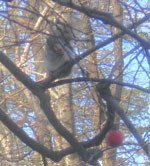
| Historic
Watershed Maps |
|
| Activities |
|
| you are here: home > areas of interest/concern > McConvey House & Grounds > McConvey House & Grounds 2 | |
The grounds of the c. 1910 McConvey house, once farmland, now contain a mix of woodland and thicket habitat, playing host to a number of native plants, and providing food, shelter, and nesting areas for a variety of birds and animals. The property is especially rich in native food-producing trees that inhabit the understories and edges of woodlands, including red mulberry, persimmon (being enjoyed by a squirrel in the picture below), dogwood, sassafras, and paw paw. Larger trees include black cherry, cultivated cherry, red maple, oak, pignut hickory, tulip tree, and American Holly. Food-producing shrubs include spicebush, blackberry, and raspberry. Many of the older trees -- particularly locusts that are declining as part of the process of natural forest succession -- provide nesting sites for cavity-nesters such as flickers and chickadees, both of which regularly produce at least one brood a year on the property. Cultivated evergreens, including yew, azalea, and boxwood, also provide shelter and nesting sites for mockingbirds, catbirds, and others. Wildflowers native to the property or propagated from local seedstock include woodland sunflower (popular with goldfinches), common blue and canada violets, avens, fleabane, jewelweed, mayapple, bloodroot, and several species each of aster and goldenrod. The property is regularly visited not only by a large variety of birds, but also by deer (now somewhat overabundant in our area), red fox, raccoons, and rabbits. As in much of the Burke's Spring Branch watershed, there are also problems with invasive alien plant species, including English Ivy, vine and bush honeysuckles, rosa multiflora, garlic mustard, and (a very new arrival, so far held at bay) mile-a-minute.
To learn more about the construction and interior of the house, please see page 3 . |
|
| Home | Watershed Map & Areas of Interest/Concern |
Historic Watershed Maps | Activities | Contact/Join Us |
All items copyright © 2003-2005
Friends of Burke's Spring Branch unless another source is noted.
Copyright for items with identified authorship remains with the
author(s); historical and other documents reproduced here are, to
the best knowledge of the webmaster, in the public domain. Items
under Friends of Burke's Spring Branch copyright may be reproduced
for nonprofit research or educational use as long as this copyright
notice is included. Please direct comments and questions to Cathy
Saunders. |
